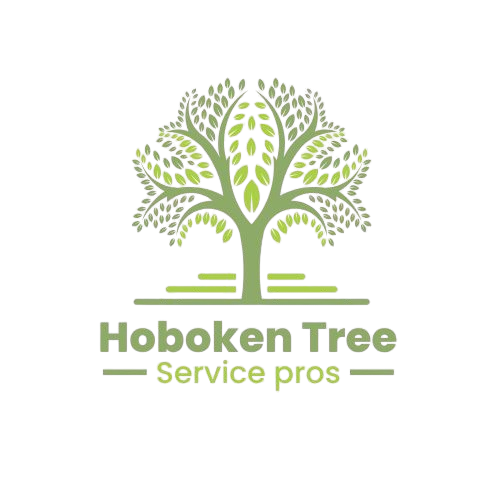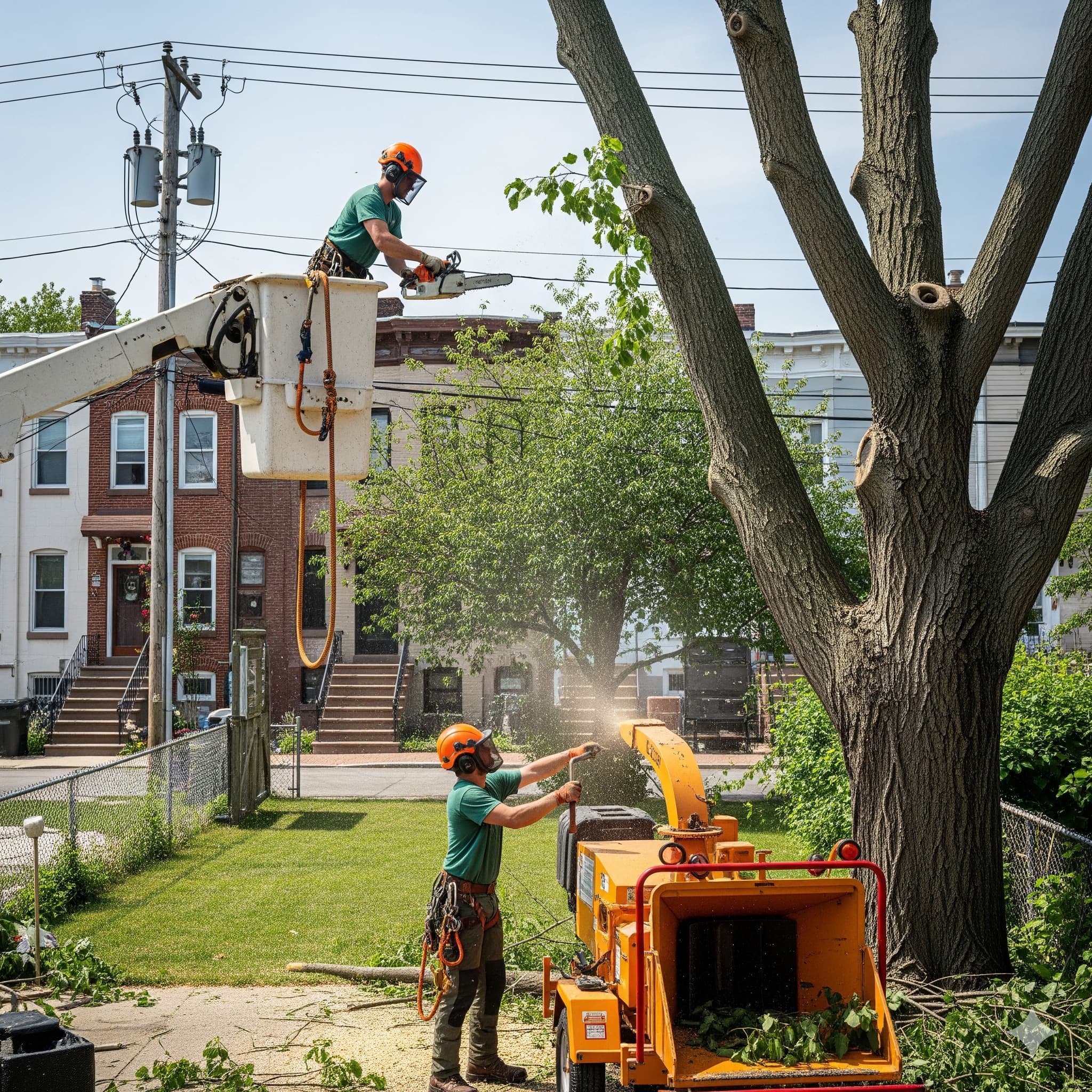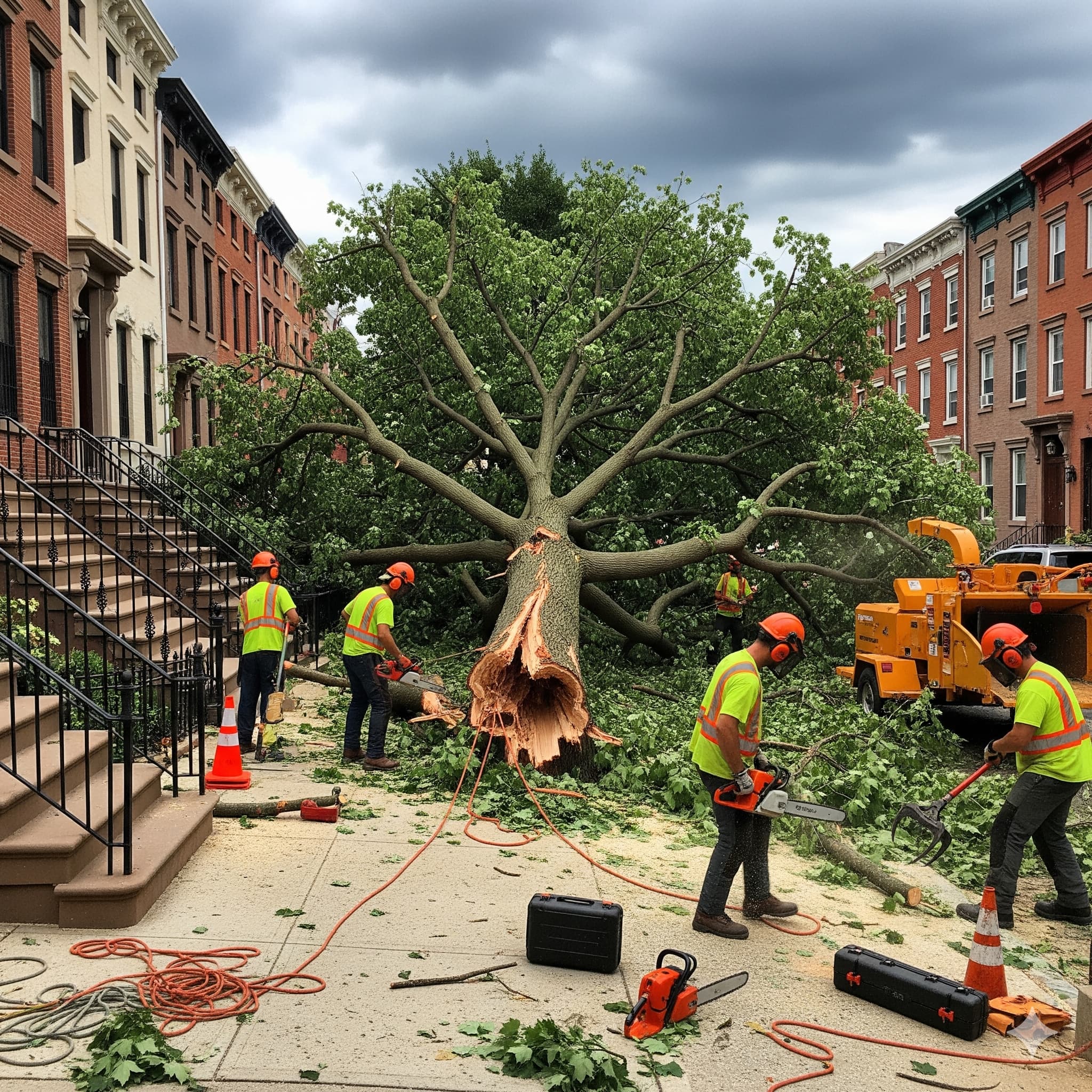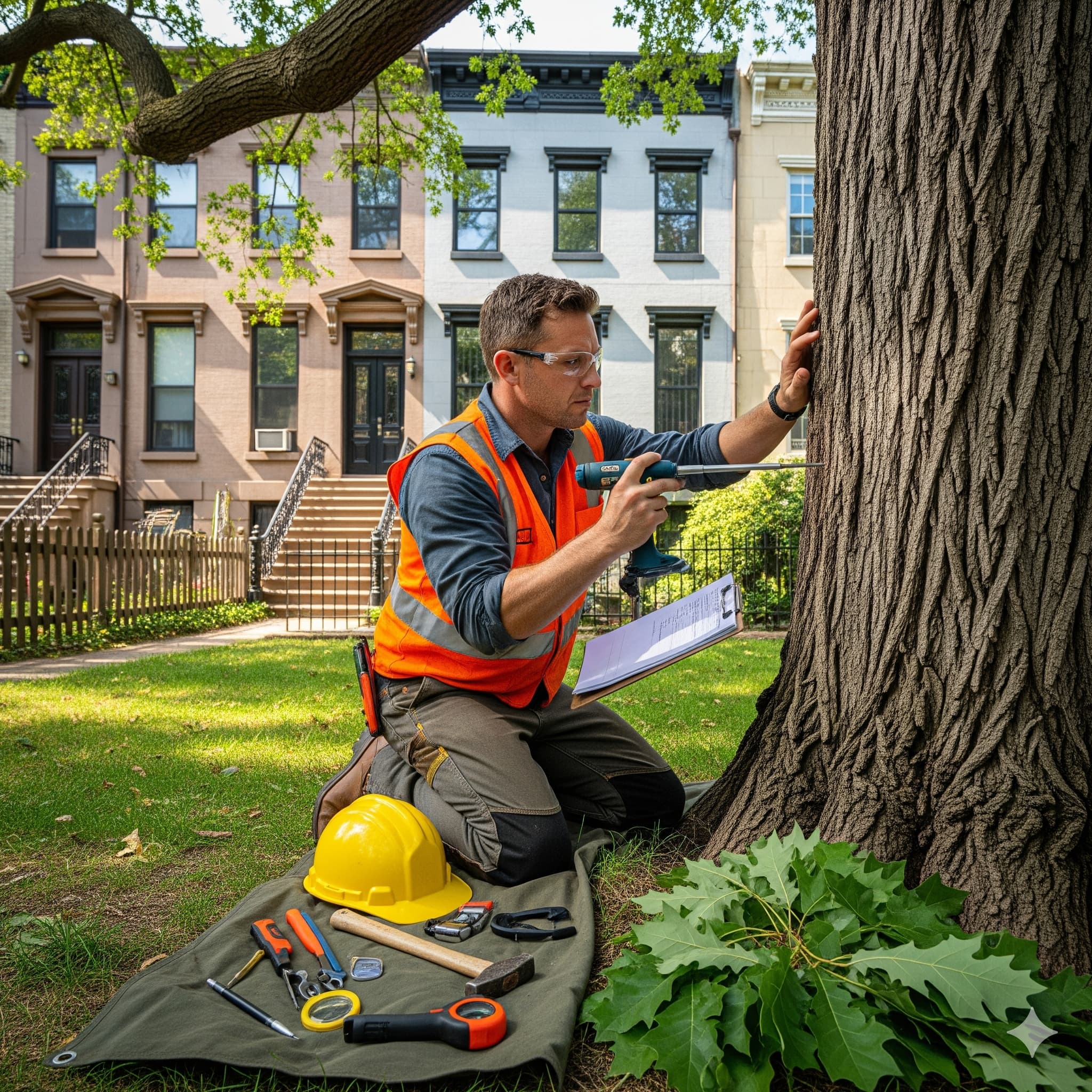
Tree Health Assessments: A Must for Hoboken Homes
Tree Health Assessment Hoboken
In Hoboken’s unique coastal urban environment, where salt air meets dense development and extreme weather events are increasingly common, a comprehensive tree health assessment has become essential for protecting both property values and public safety. Unlike rural trees that grow in natural environments, Hoboken’s urban forest faces multiple stressors that can significantly impact tree longevity and stability. Professional tree health assessments provide the early detection and preventive care necessary to maintain healthy, thriving trees in this challenging environment.
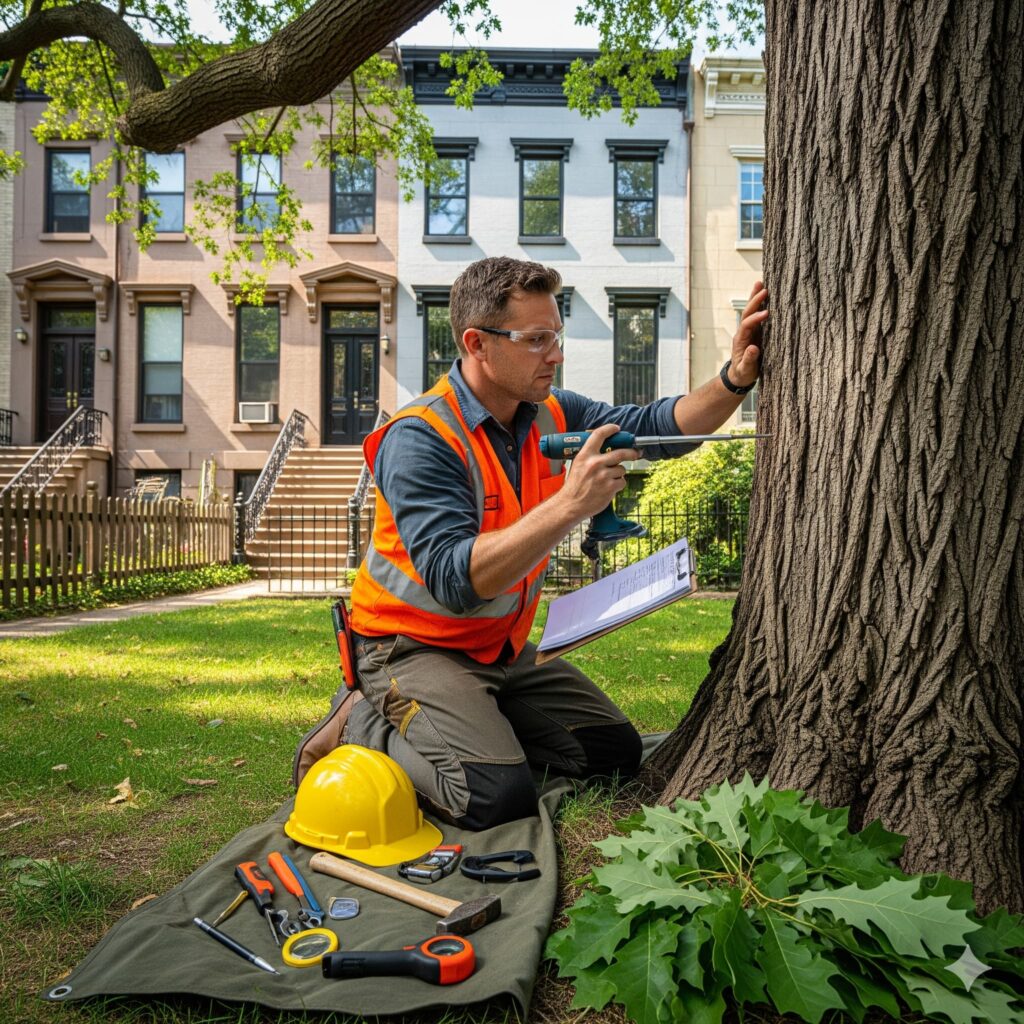
Understanding Urban Tree Health Challenges in Hoboken
Hoboken’s trees contend with a complex array of environmental stressors that make regular health assessments critical. The city’s location along the Hudson River exposes trees to salt spray and flooding, while urban conditions create additional challenges, including soil compaction, limited root space, air pollution, and heat island effects. These factors combine to create an environment where trees are more susceptible to diseases, pest infestations, and structural failures.
Professional tree health assessments evaluate how these urban stresses affect individual trees, identifying early warning signs before they become serious problems. In Hoboken’s dense residential areas near landmarks like Church Square Park and along busy corridors like Washington Street, early detection through systematic health evaluation can prevent costly emergency removals and protect pedestrian safety.
Coastal Environmental Impact on Tree Health
The coastal location significantly impacts tree health in ways that may not be immediately apparent to homeowners. Saltwater flooding during storms can cause delayed stress responses, with some trees showing symptoms months or even years after exposure. Research has shown that saltwater flooding can negatively impact trees, with some species experiencing high mortality rates while others may recover over time with proper care.
Regular tree health assessments help identify salt damage early, when treatment options are most effective. Professional arborists understand how coastal conditions affect different tree species and can recommend appropriate care strategies to help trees recover from salt exposure and develop resilience against future events.
Common Tree Health Issues in Hoboken’s Urban Environment
Several specific tree health problems are particularly common in Hoboken’s urban environment. The emerald ash borer has been detected throughout New Jersey and poses a significant threat to ash trees, with affected trees typically dying within three to four years without treatment. Early detection through professional assessment allows for preventive treatments that can protect valuable ash trees.
Fungal tree diseases such as anthracnose, Dutch elm disease, and various leaf spot diseases thrive in urban environments where air circulation is limited and moisture levels fluctuate. These diseases can weaken trees and make them more susceptible to other problems. A comprehensive tree health assessment identifies fungal infections in their early stages, when treatment is most effective and less expensive.
The spotted lanternfly, now present in all New Jersey counties, represents another significant concern for tree health. This invasive pest feeds on a wide range of tree species and can weaken trees, making them more vulnerable to other stresses. Professional assessments include monitoring for this and other invasive pests that threaten Hoboken’s urban forest.
Bacterial Leaf Scorch and Urban Tree Decline
Bacterial leaf scorch, caused by Xylella fastidiosa, has become a serious concern for urban trees, particularly red oaks, which serve as New Jersey’s state tree. This disease is spread by leafhoppers and other insects, causing leaf edges to turn brown and trees to decline slowly over several years. In urban environments where red oaks are common landscape trees, this disease can significantly impact property values and neighborhood aesthetics.
Professional tree health assessments include evaluation for bacterial diseases that can be difficult for property owners to distinguish from other problems. Early diagnosis allows for appropriate management strategies, even though treatment options for bacterial diseases are limited.
Professional Tree Health Assessment Process
A comprehensive tree health assessment involves a systematic evaluation of multiple factors that affect tree vitality and structural integrity. Certified arborists examine tree structure, looking for signs of decay, cracks, or other structural defects that could lead to failure. They assess foliage quality, checking for discoloration, defoliation, or abnormal growth patterns that indicate health problems.
Soil conditions receive particular attention in urban assessments, as compacted soils and poor drainage significantly impact tree health. Arborists evaluate root systems for damage, girdling roots, or signs of root rot that can compromise tree stability. In Hoboken’s dense environment, where construction and infrastructure changes are common, root damage from excavation or soil compaction is a frequent concern.
Professional assessments also include pest and disease monitoring, with arborists trained to identify early signs of infestations or infections that may not be obvious to property owners. This expertise is particularly valuable in identifying invasive species or emerging pest problems before they become widespread.
Advanced Diagnostic Techniques
Modern tree health assessments utilize advanced diagnostic tools that provide detailed information about tree condition. Resistograph testing can detect internal decay without damaging the tree, while air spade excavation allows for examination of root systems without destructive digging. These techniques are particularly valuable for assessing mature trees in urban environments where root space is limited.
Digital photography and mapping create permanent records of tree conditions, allowing for monitoring of changes over time. This documentation is valuable for tracking treatment effectiveness and planning long-term care strategies.
Hoboken’s Tree Health Regulations and Requirements
The City of Hoboken has established comprehensive regulations through its Shade Tree Commission to protect and maintain the urban forest. These regulations specifically prohibit placing or distributing chemicals, including salt, that are deleterious to tree health, recognizing the particular vulnerability of urban trees to chemical damage.
The Commission has the authority to administer treatment to, or remove, any tree situated on private property that is believed to harbor disease or insects that pose a threat to other trees in the community. This regulatory framework emphasizes the importance of maintaining tree health not just for individual properties, but for the entire urban forest.
Property owners have responsibilities under these regulations to maintain trees in a healthy condition and report potential problems that could spread to neighboring trees. Professional tree health assessments help ensure compliance with these requirements while protecting property owners from potential violations.
Municipal Tree Health Programs
The Hoboken Shade Tree Commission maintains a complete inventory of all trees in the city and has developed specific standards for tree care and maintenance. The Commission’s goal of maintaining 4,000 healthy, well-maintained trees on city and county streets requires ongoing monitoring and assessment of tree health throughout the community.
Understanding how municipal programs interface with private tree care helps property owners coordinate their tree health efforts with community-wide initiatives. Professional assessments can identify trees that might benefit from municipal programs or require coordination with city officials for proper management.
Benefits of Regular Tree Health Assessments
Regular professional tree health assessments provide multiple benefits that extend beyond immediate tree care needs. Early detection of problems allows for less expensive, less invasive treatments that are more likely to be successful. Preventive care identified through assessments can significantly extend tree life and reduce the likelihood of emergencies.
From a property value perspective, healthy, well-maintained trees can add significant value to homes in Hoboken’s competitive real estate market. Properties near Stevens Institute of Technology or along the waterfront particularly benefit from mature, healthy trees that enhance curb appeal and provide environmental benefits.
Safety benefits cannot be overstated in Hoboken’s dense urban environment. Regular assessments identify structural problems before they lead to branch or tree failures that could damage property or injure people. This proactive approach is particularly important for trees near high-traffic areas like Hudson Street or around schools and parks.
Insurance and Liability Considerations
Professional tree health assessments create documentation of responsible tree care that can be valuable in insurance claims or liability situations. Insurance companies increasingly recognize the value of preventive tree care and may provide coverage benefits for properties with documented tree maintenance programs.
In legal situations involving tree-related property damage, professional assessment records demonstrate that property owners took reasonable steps to maintain tree health and identify potential hazards. This documentation can be crucial in determining liability and protecting property owners from unfounded claims.
Seasonal Considerations for Tree Health Assessments
Different seasons provide optimal opportunities for assessing various aspects of tree health. Spring assessments can identify winter damage and evaluate leaf-out patterns that indicate tree vitality. Summer assessments allow for evaluation of foliage quality and pest activity when symptoms are most apparent.
Fall assessments are particularly valuable for identifying structural issues as leaves drop and tree architecture becomes more visible. Winter assessments focus on structural integrity and can identify hazards that need attention before spring growth begins.
In Hoboken’s coastal climate, seasonal variation in salt exposure, storm frequency, and temperature fluctuations creates different stresses throughout the year. Professional arborists understand these seasonal patterns and can time assessments to capture the most relevant information for each tree’s health status.
Storm Preparedness and Recovery
Given Hoboken’s exposure to coastal storms and extreme weather events, tree health assessments play a crucial role in storm preparedness. Pre-storm assessments can identify trees that are likely to fail during severe weather, allowing for preventive removal or treatment that reduces storm damage risks.
Post-storm assessments are equally important for identifying delayed stress responses and hidden damage that may not be immediately apparent. Trees near areas like Pier A Park or along River Street may appear undamaged after storms, but still require professional evaluation to identify potential problems.
Developing Long-Term Tree Health Management Plans
Professional tree health assessments provide the foundation for developing comprehensive, long-term tree care plans that address both immediate needs and future concerns. These plans consider tree species characteristics, site conditions, and property owner goals to create sustainable management strategies.
Long-term planning is particularly important in urban environments where trees face ongoing stresses and where replacement of mature trees is expensive and time-consuming. Properties near landmarks like the Hoboken Historical Museum or in historic districts benefit from preservation strategies that maintain tree health while respecting neighborhood character.
Effective long-term plans also consider infrastructure development, climate change impacts, and evolving pest and disease pressures that may affect tree health in the future. This forward-thinking approach helps ensure that tree investments provide maximum long-term value.
Species Selection and Diversification
Tree health assessments often reveal the importance of species diversity in urban landscapes. Over-reliance on particular species can create vulnerability to species-specific pests and diseases. Professional assessments can identify opportunities for diversification that improve overall landscape resilience.
In Hoboken’s challenging urban environment, selecting appropriate tree species is crucial for long-term success. Professional assessments help property owners understand which species thrive in specific site conditions and which may require more intensive management to remain healthy.
For comprehensive tree health assessment services in Hoboken, NJ, contact Hoboken Tree Service Pros. Our certified arborists provide thorough evaluations that identify current health issues and develop strategies to maintain the long-term vitality of your trees in Hoboken’s unique urban coastal environment.
